
scenarios
 OA + Enterprise Management System
OA + Enterprise Management System
Traditional OA includes document, workflow and collaboration management and some other functions to improve usability.  is a new generation, advanced OA application which automatically connects to CRM, HCM and PM enabling the underlying data to interlink with each other.
is a new generation, advanced OA application which automatically connects to CRM, HCM and PM enabling the underlying data to interlink with each other.  not only provides assistance in managing processes, communication and team work for new employees, it also helps experienced ones in tracking, analyzing data, in report generation and extracting business intelligence.
not only provides assistance in managing processes, communication and team work for new employees, it also helps experienced ones in tracking, analyzing data, in report generation and extracting business intelligence.  OA allows both new employees and experienced ones to customize different menus and interfaces.
OA allows both new employees and experienced ones to customize different menus and interfaces.

 allows each employee to define his workbench with which he can select real-time display components that are related to his work area.
allows each employee to define his workbench with which he can select real-time display components that are related to his work area.
To define workbench
 allows each employee to define his workbench and its components so that they can directly carry out their work in the workbench after log-in.
allows each employee to define his workbench and its components so that they can directly carry out their work in the workbench after log-in.
Work Task Assignment, Calendar and Alert
 allows each employee to assign the task. When the work plan is arranged on the personal e-calendar, the system will accordingly inform you by sending alert or notification to make sure that each task will not be missed.
allows each employee to assign the task. When the work plan is arranged on the personal e-calendar, the system will accordingly inform you by sending alert or notification to make sure that each task will not be missed.
Real-time assignment condition (my subordinates and me)
 allows employees to track how the assignment is run by the work calendar in real-time and the supervisor can check how the assignment and performance status of the subordinates.
allows employees to track how the assignment is run by the work calendar in real-time and the supervisor can check how the assignment and performance status of the subordinates.
Problem Management
 provides an issue management mechanism, supporting the whole process from employee’s raising the issue, accepting the issue assignment, submitting a proposal to resolve the issue to closing the issue.
provides an issue management mechanism, supporting the whole process from employee’s raising the issue, accepting the issue assignment, submitting a proposal to resolve the issue to closing the issue.
 has clear issue mgmt steps to promote efficiency and encourage the employees to put up their issues and solve them as soon as possible.
has clear issue mgmt steps to promote efficiency and encourage the employees to put up their issues and solve them as soon as possible.
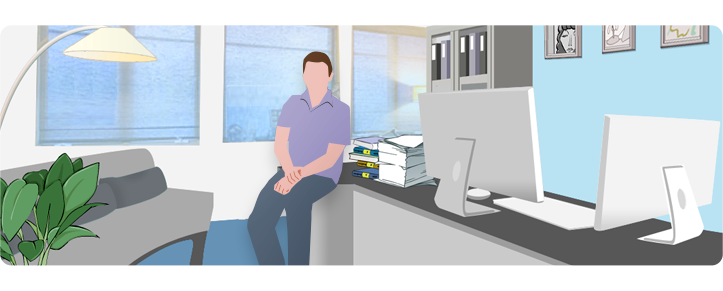
 provides multiple self-service features which the enterprise may provide to satisfy reasonable needs from the employees.
provides multiple self-service features which the enterprise may provide to satisfy reasonable needs from the employees.
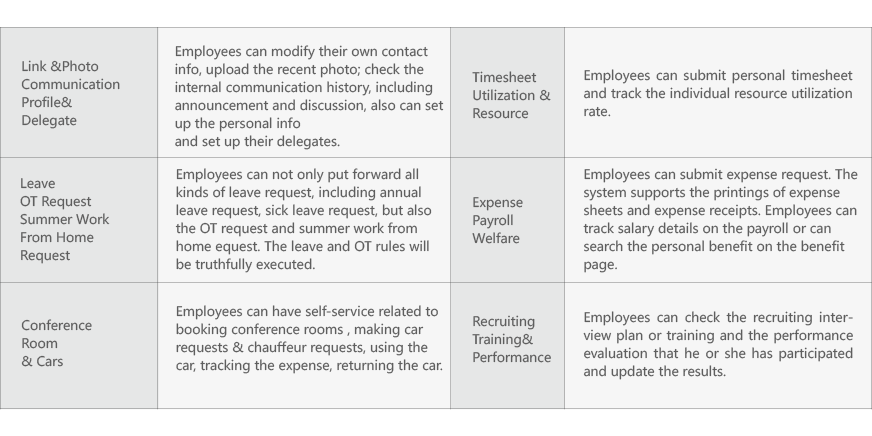

 provides a Generic Form and User-defined Workflow facility to allow users to create different notification and request forms for reviews, comments and approvals. It also provides the Employee Portal for each employee. In the Employee Portal, the employee can access to different facilities such as:
provides a Generic Form and User-defined Workflow facility to allow users to create different notification and request forms for reviews, comments and approvals. It also provides the Employee Portal for each employee. In the Employee Portal, the employee can access to different facilities such as:
 also can search and account the form by its type, requestor, and/or request time.
also can search and account the form by its type, requestor, and/or request time.  can also calculate the sum, average, max and min of the form values.
can also calculate the sum, average, max and min of the form values.

 allows employees to know more about clients and business and provides 360 °client basic Information.
allows employees to know more about clients and business and provides 360 °client basic Information.
 not only helps the employees to record and track the clients’ interactions and actions, but also provides call center summary page enabling the employee to have an overview of the client.
not only helps the employees to record and track the clients’ interactions and actions, but also provides call center summary page enabling the employee to have an overview of the client.
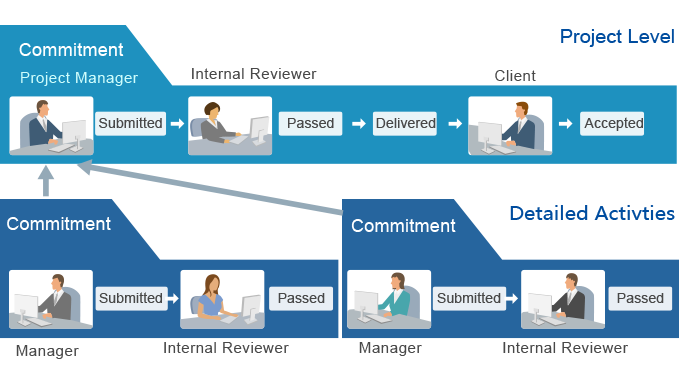
Managing a project is never simple but can be simpler if the following exist:
 supports both static planning and dynamic execution. It supports PM methodology and automatically tracks, interprets and reports on project performance. The project manager, relieved from routine data tracking and interpreting, is free to engage in more value-added tasks of project performance optimization. Simple PM is designed to simplify the planning and execution of project management and to assure success.
supports both static planning and dynamic execution. It supports PM methodology and automatically tracks, interprets and reports on project performance. The project manager, relieved from routine data tracking and interpreting, is free to engage in more value-added tasks of project performance optimization. Simple PM is designed to simplify the planning and execution of project management and to assure success.
If you do not have  , you do not have half of the tools that you need to do your job. You’ll be using your limited memory capacity to reconcile the slow, inaccurate human-input information with your sense of the reality. It isn’t that you aren’t smart and hardworking, but you need adequate tools. You’ll become vulnerable when the complexity that you are dealing with escalates but your memory capacity doesn’t.
, you do not have half of the tools that you need to do your job. You’ll be using your limited memory capacity to reconcile the slow, inaccurate human-input information with your sense of the reality. It isn’t that you aren’t smart and hardworking, but you need adequate tools. You’ll become vulnerable when the complexity that you are dealing with escalates but your memory capacity doesn’t.

 provides features for searching, requesting, allocating and tracking of resources in multiple sites, groups, PMOs, projects and activities. It automates cost estimating and budgeting and tracks actual against plan.
provides features for searching, requesting, allocating and tracking of resources in multiple sites, groups, PMOs, projects and activities. It automates cost estimating and budgeting and tracks actual against plan.
For human resource management, it automatically detects skill set gaps and overloading. It can aggregate data (e.g., skill set gaps, time spent, deliverable results) from lowest activities to the highest portfolios or groups.
 also supports advanced resource management features such as resource provisioning, prediction of future needs and skill set search.
also supports advanced resource management features such as resource provisioning, prediction of future needs and skill set search.
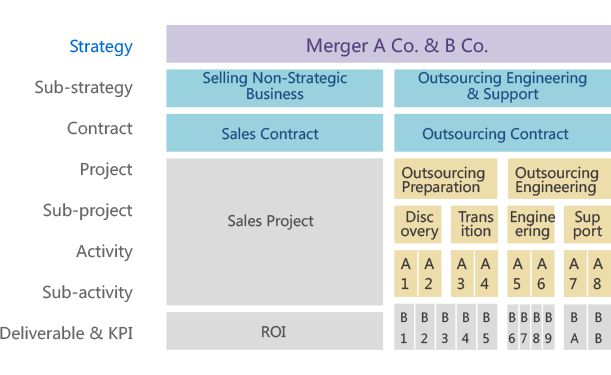
Strategy failure is often caused by the strategy being too macroscopic and without a viable plan to support it. Even if there is a plan, executive power is lacking, which leads to either the plan is disjointed with the strategy or unable to implement effectively later on. When nothing happens after a while, the team, based on their experience of “strategy failure” know that strategy would change, that they just need to wait awhile and would not have to diligently spend efforts on these unachievable strategic goals. These strategies are just beyond the capability of the team.
 is able to discompose the strategic goal in the topmost level and associate it with the deliverables in the lower levels. This means strategy planner may relate the interactions among each level during the proposal and planning stage; otherwise, this strategy may be regarded as unrealistic by others. When starting to carry out the strategy,
is able to discompose the strategic goal in the topmost level and associate it with the deliverables in the lower levels. This means strategy planner may relate the interactions among each level during the proposal and planning stage; otherwise, this strategy may be regarded as unrealistic by others. When starting to carry out the strategy,  shows the effects resulted from each deliverable to the strategic goals. it not only provides the measure, more importantly, it lets decision makers understand the interactions and difficulties of the strategy at each level, and to provide means to adjust the execution approach, intensity or the strategic goals as early as possible.
shows the effects resulted from each deliverable to the strategic goals. it not only provides the measure, more importantly, it lets decision makers understand the interactions and difficulties of the strategy at each level, and to provide means to adjust the execution approach, intensity or the strategic goals as early as possible.
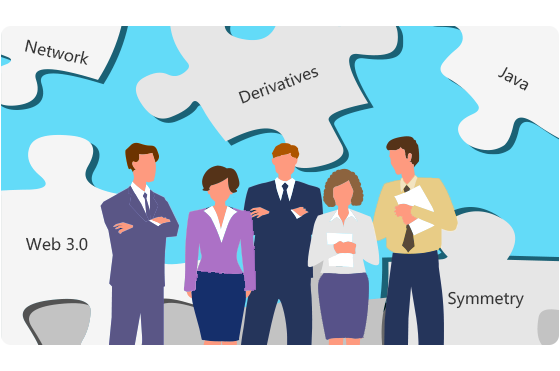
 provides a thorough system to manage documents by putting them in different libraries and files, allowing users to keep files in order and compile them into indices.
provides a thorough system to manage documents by putting them in different libraries and files, allowing users to keep files in order and compile them into indices.  also offers a mechanism for the users to check in, check out and control document versions. This document management system can be used both as a separate module and as a joint one connected with other modules. For example, it allows a connected library to be created automatically when adding a new contract or a new project by relevant policy settings, further continuing to use the same file settings of the pre-defined library templates. Moreover, it supports to instantly move the documents from any contract or any project into a library and the relevant document link of the contract or the project will automatically be updated.
also offers a mechanism for the users to check in, check out and control document versions. This document management system can be used both as a separate module and as a joint one connected with other modules. For example, it allows a connected library to be created automatically when adding a new contract or a new project by relevant policy settings, further continuing to use the same file settings of the pre-defined library templates. Moreover, it supports to instantly move the documents from any contract or any project into a library and the relevant document link of the contract or the project will automatically be updated.
 also supports the function of classifying knowledge, allowing users to compile documents into indices and search for them by knowledge classifications, which can be pre-defined in enterprise policies.
also supports the function of classifying knowledge, allowing users to compile documents into indices and search for them by knowledge classifications, which can be pre-defined in enterprise policies.
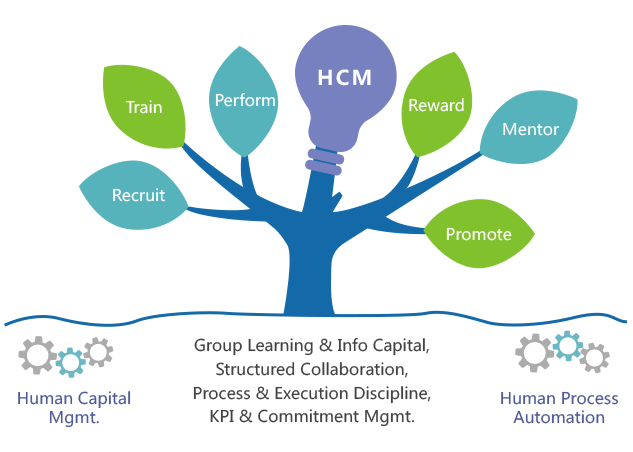
 offers various functions to satisfy your real-time needs for HCM automation management. These include recruitment, employee record, attendance, resource utilization, compensation, payroll, benefit plan, training, performance, online leave request and self-service etc. All of these functions help you manage and control HCM more effectively. It provides a complete platform to manage Group Learning & Information Capital, Structured Collaboration, Process & Execution Discipline and KPI & Commitment Management, which not only improves the enterprise’s core competence greatly, but also creates competitive advantages for the long-term development.
offers various functions to satisfy your real-time needs for HCM automation management. These include recruitment, employee record, attendance, resource utilization, compensation, payroll, benefit plan, training, performance, online leave request and self-service etc. All of these functions help you manage and control HCM more effectively. It provides a complete platform to manage Group Learning & Information Capital, Structured Collaboration, Process & Execution Discipline and KPI & Commitment Management, which not only improves the enterprise’s core competence greatly, but also creates competitive advantages for the long-term development.
All in all,  can both meet the enterprise’s short- term demand for automation and promote the enterprise’s long-term human capital competitive advantage.
can both meet the enterprise’s short- term demand for automation and promote the enterprise’s long-term human capital competitive advantage.
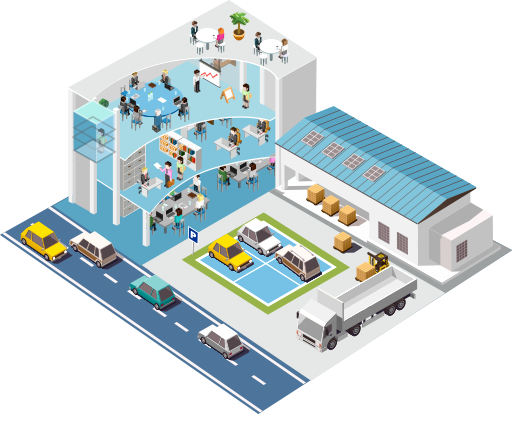
 allows the administrator to enroll and assign office facilities, as well as information maintenance and tracking. Regular employees may search and apply for various kinds of equipment and facilities conveniently. This improves the efficiency of equipment and facilities utilization and makes it easy to track the equipment and facilities and their availability.
allows the administrator to enroll and assign office facilities, as well as information maintenance and tracking. Regular employees may search and apply for various kinds of equipment and facilities conveniently. This improves the efficiency of equipment and facilities utilization and makes it easy to track the equipment and facilities and their availability.
Regardless of the kinds or quantity of equipment and facilities, the administrator is able to control them in perfect order in  . The Administrator can define the facility’s type and attribute in each site, as well as assigner or default approval flow; Administrator can also acquire the conflict condition of applied facilities and make adjustments. Best of all, administrator can conduct search based on applicant, application period and facility utilization state, and all the history records of facility utilization can be tracked.
. The Administrator can define the facility’s type and attribute in each site, as well as assigner or default approval flow; Administrator can also acquire the conflict condition of applied facilities and make adjustments. Best of all, administrator can conduct search based on applicant, application period and facility utilization state, and all the history records of facility utilization can be tracked.
By using facility management, employees can apply for various facilities in their own site by themselves and obtain the needed facilities through listing the related information, such as type and quantity. The facilities also can be returned in  by employees, if there are cost generated, the amount can be enrolled, which helps administrator to track and control the cost.
by employees, if there are cost generated, the amount can be enrolled, which helps administrator to track and control the cost.
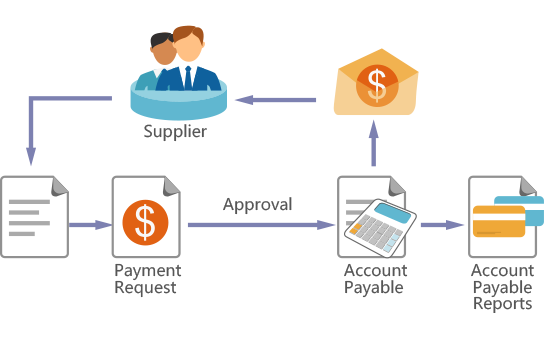
 supports the entire procurement process from purchase requisition to payment. Purchase orders, invoices and payment requests can be managed by each department separately and by corporate as a whole.
supports the entire procurement process from purchase requisition to payment. Purchase orders, invoices and payment requests can be managed by each department separately and by corporate as a whole.  also provides a framework for sophisticated contract management for complex acquisitions.
also provides a framework for sophisticated contract management for complex acquisitions.
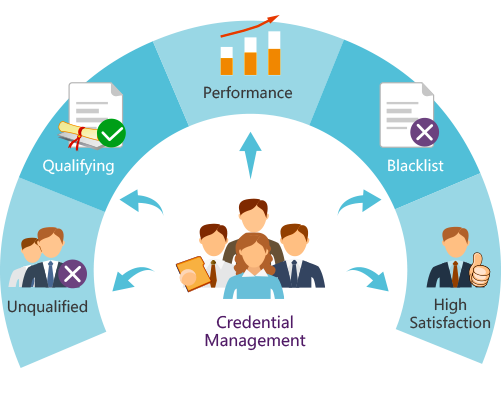
Decision making.  Supplier & Procurement Management provides comprehensive supplier information in the following ways:
Supplier & Procurement Management provides comprehensive supplier information in the following ways:

 provides the following different sub-ledgers and tools to help different user groups keep track of incomes and expenses:
provides the following different sub-ledgers and tools to help different user groups keep track of incomes and expenses:
 also provides a comprehensive set of pre-defined financial reports for each of the above areas.
also provides a comprehensive set of pre-defined financial reports for each of the above areas.

 provides the necessary tools to manage assets, you can conduct assets transfer or assignment with flexibility. Assets can be circulated reasonably among multiple sites within the enterprise. As a result, the administrator is able to arrange assets transfer in each site according to assets utilization, and only when this transfer is approved will it become effective. Also, each assets transfer from site to site will be recorded in
provides the necessary tools to manage assets, you can conduct assets transfer or assignment with flexibility. Assets can be circulated reasonably among multiple sites within the enterprise. As a result, the administrator is able to arrange assets transfer in each site according to assets utilization, and only when this transfer is approved will it become effective. Also, each assets transfer from site to site will be recorded in  system. This helps to track the assets status and transfer records in each site.
system. This helps to track the assets status and transfer records in each site.
 also supports assets assignment. The assets in warehouse can be assigned to certain user or multiple users. Besides the assignment time and quantity,
also supports assets assignment. The assets in warehouse can be assigned to certain user or multiple users. Besides the assignment time and quantity,  can be used to record the return time and assets’ condition to reflect the latest assets’ condition. Also, related report is available to track the allocation, surplus and assets condition.
can be used to record the return time and assets’ condition to reflect the latest assets’ condition. Also, related report is available to track the allocation, surplus and assets condition.




